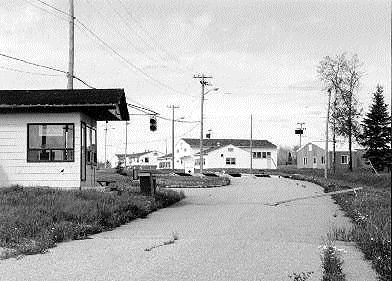
|
|
Lowther Gate Click for larger, marked up image. |
March 1998 – Gene McManus]
A Year at Lowther; the early days…

|
|
Lowther Gate Click for larger, marked up image. |
March 1998 – Gene McManus]
I was a Ground Radar Maintenance technician in the U.S. Air Force, having trained at Keesler Air Force Base in Biloxi, Mississippi, and serving my apprenticeship for about a year at the 786th AC&W Squadron at Minot, North Dakota. I was trained and rated as a technician on the AN/FPS-14 "Gap Filler" radar system, which supposed to provide radar coverage in small gaps or blind spots in the larger GCI radar coverage, and was a part of the SAGE system. While at Minot, an "overseas" assignment for AN/FPS-14 radar techs was announced for duty at Lowther. There were two Gap Filler techs at Minot, my crew chief, SSgt. Ed Baake, and myself. I had been having some personal problems with Ed for a couple of months, and so I decided that whatever he decided, I’d do the opposite. So when Ed decided that he would stay at Minot, I put in my transfer paperwork. I was a 19 year old two-striper, Airman Second Class, A2C for short.
I left Minot in June 1958 for a couple weeks leave at home, and then reported to Selfrige AFB, near Detroit, Michigan. I spent about three weeks at Selfrige, getting prepped for "overseas" duty in Canada. Considerable dental work was done, because there was no Air Force dental or hospital facilities anywhere near my new duty station in Canada. In between infrequent trips to the dental clinic and the hospital for tests, I spent most of the time on one kind of unpleasant detail or another. Finally, after about three weeks, I left Selfrige, driving my very nearly clapped-out ’52 Ford sedan across southern Ontario to connect with the northern highway to North Bay, and Lowther.
Lowther village, and the radar station just to the east of the village (at least I think the station was east of the village – remember, no notes), lies just about exactly half way between Kapuskasing (Kap), and Hearst, some 60 miles further west on highway 11, and nearly 200 miles straight north of the Soo (Sault Ste. Marie), as the crow flies. As I progressed north from North Bay, the land became less and less populated and highway 11 turned generally west. Kap was a town of about 5500-population back then, and after driving for several hours seeing smaller and smaller villages, further and further apart along the way, it seemed like a metropolis. There was even a "Sears" store (Simpson-Sears in Canada, not Sears-Roebuck). Imagine my shock as I drove further west of Kap, when suddenly the nicely paved two-lane highway turned to soft, sticky, mud!
This mud continued for about 30 miles, and Lowther sat squarely in the middle of the length of mud road. Leaving the radar station, no matter whether you were bound for Kap or Hearst, you were first faced with about 15 miles of mud! This area was very swampy, and the roadbed and surrounding berms were continually sinking. Around each utility pole along the road was a mound of rocks to stabilize the poles as they settled into the ooze. As it turned out, the road was at its best in the dead of winter when it was frozen solid. It was very rough, but at least you wouldn’t sink out of sight. That is, you could if your car would start. Mine never did all winter.
The area from near North Bay almost all the way west to Thunder Bay (then twin cities of Fort William and Port Arthur) at the west end of Lake Superior was heavily forested in relatively small pine trees, used mostly for pulpwood. Carved out of the forest on the north side of highway 11, was the 639th Squadron. For some reason, AC&W was never used as part of this site’s name, although it was most certainly an Air Control & Warning site. The station was quite new, having become operational only a month or so before I arrived. The growing pains, particularly the administrative growing pains, were an endless cause of frustration to me during my stay.
Even though the assignment at Lowther was for an AN/FPS-14 Gap Filler technician, there was no AN/FPS-14 there, and none scheduled. My new NCOIC (Non-Commissioned Officer in Charge), TSgt. Roddy (might have been spelled Roddie) was likewise surprised when I arrived and wasn’t qualified on the radars which were installed, the AN/MPS-7 L-band search radar, and AN/MPS-14 S-band height-finder radar, mobile versions of the AN/FPS-3 and AN/FPS-6, resp. The confusion over my qualifications may have arisen because of the similarity in designation of the AN/FPS-14 and AN/MPS-14. Likely some "soft-core" orderly room guy got them mixed up (certainly not a radar tech…!) For the record, these weren’t mobile, but permanently mounted atop three story towers, with the antennae under inflated rubber radomes. Apparently, there had been some confusion during the site build-up, over when the height-finder would be ready, as there was an AN/TSP-10D, X-band height-finder, which was out of service installed as well. Some of our early work was to dismantle this unit. The tower where it had been installed was used only for storage as long as I was there.
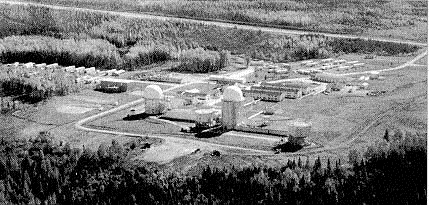
|
|
Lowther Site Click for larger, marked up image. |
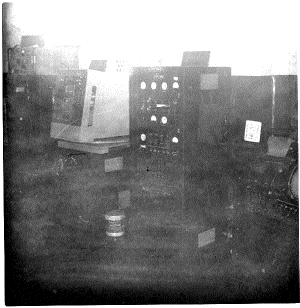 MPS-7 electronics in the radar maintenance shop. |
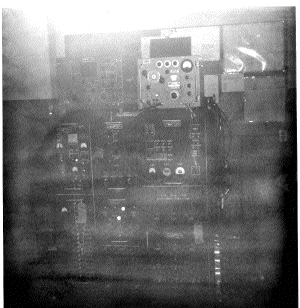 More MPS-7 electronics in the radar maintenance shop. |
The AN/MPS-14 and it's "fixed" counterpart, the AN/FPS-6, radiated a peak power of about one megawatt (1,000,000 watts) on the S-band. S-band, we learned in tech school, is particularly harmful to flesh, and particularly eyes and testicles. (We were so happy to work closely with it...) We were careful, and did a small experiment. Someplace we found a dead duck, and during one maintenance cycle, hung it from the MPS-14 feed horn and fired the transmitter for a moment. We found most of the feathers along with a large puddle of grease on the tower floor! There was an incident with this radar on the site. It set the PX on fire!. As the antenna nodded up and down, it would radiate below the horizon, downward somewhat. There were limit switches on the antenna which would disable the transmitter when the antenna was pointed toward the site area, and when the nod was below a certain level. They apparently had not been set properly during installation, and at some point, when the antenna was pointed southward, the energy beam set off several crates of flashbulbs in the PX, causing a small fire, and lots of panic. The tungsten flashbulb filaments used in those days was happy to absorb large amounts of the radar energy and, poof! It was a funny incident that could have been tragic.
For those who weren’t around at this early period, these radars were all vacuum tubes, no transistors or integrated circuits on these, and fully manual in operation; no computerization here. At this period of time, I had seen exactly one transistor in my life, and had no idea at all how it worked. There was a single transistor in the receiver circuitry of the AN/FPS-14. I don’t remember what it was used for, or why a transistor when everything else used vacuum tubes.
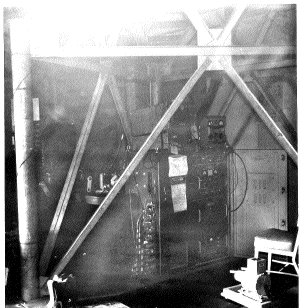 MPS-14 transmitter and pre-amp electronics in the MPS-14 tower. |
During this period of the cold war, the USAF Air Defense Command, of which we were a part, was under terrific pressure from Strategic Air Command boss, Gen. Curtis LeMay. The story as I recall it was the Gen. LeMay some time previously had taken a flight of B-47s to England where they were painted without national markings, and IFF transponders and communications equipment which might identify them as American were removed. This flight of B-47s then tested the North American defenses by flying over northern Canada, entered U.S. airspace and were not intercepted until they had penetrated well into the central United States, with no challenge. LeMay was not happy, and proceeded to make our lives less than pleasant in return. Once a month, it seems, perhaps more, we were tested by flights of bombers on simulated missions.
First, the PPI radarscopes would begin to light up with jamming, beginning with multiple, long lines of "window" or "chaff" sometimes extending for 60 or 80 miles each across the scopes. Later would come electronic jamming, causing the scopes to pulsate with indecipherable strobes of light. In this electronic mess, our scope dopes (radar operators) would have to find the bombers, calculate GCI headings and altitudes, and scramble fighters, both American and Canadian. Some of these raids would go on for hours, with the missions lasting for several days at a time. During these, we’d work 6-on, 6-off, 12 hours per day. This would allow us to cover the radar duties and man guard patrols around the secure perimeter. While the missions were underway, a PPI scope in the corner of the radar maintenance room with a 35mm movie camera attached, would record the whole event, for later headquarters evaluation. The camera would snap one frame each revolution of the search radar. The film was classified "Secret", and shipped to headquarters following each mission. I always wanted to see one of these played back, but never did.
Once in a while, after the successful conclusion of a mission, we would be able to call in a flight of interceptors for a "bubble check". This was a high-speed, low altitude, very noisy pass or two over the station. It was always the most fun to do this at about 3am. It seemed as though the RCAF pilots, in their CF-100s were more adventuresome than their American counterparts. The Canucks were always lower, always faster, and always made more passes than the Yanks. On one very memorable occasion, a pair of RCAF CF-100s came over, one inverted, one right side up, one above the other, lower than the tops of the radomes. Just incredible, and we ate it up! We rarely got to see aircraft as anything more than a glowing point of light, so these occasions, and this one in particular, were really special.
On all the bomber missions, we posted guards around the secure perimeter fence, in case of saboteurs. Weapons were drawn, but not ammunition, except for one memorable occasion. When the sirens would start, we’d post guards at each of the radar towers, until we were relieved to go draw our weapons. I had a fellow on my crew named Gert Kuhn, a naturalized American citizen, who grew up in Germany. To say that Gert was rigid and disciplined would be like saying that Pamela Anderson was sort of attractive. One mission, when the siren blew, I sent Gert out to guard one of the towers. A short time later, our relief who was now armed, arrived. I sent the relief out to relieve Gert so that he could go draw his weapon. The newly arrived relief was back in the radar maintenance room in a few moments, nearly doubled over in laughter. He said, "Gene, you gotta come see this!", and led me quietly back to the tunnel. There, with a fire axe slung over his shoulder, was Gert, goose-stepping up and down the length of the tunnel! I’ll never forget this, what a sight!
On one infamous mission, the no ammunition rule was changed. Along with our carbine, we drew one loaded magazine. As it became dark, you just knew that the sentries walking the perimeter fence with the forest just a few meters away, would get nervous. This was funny, but it could have been deadly. It hadn’t been dark long when the first shots were heard. Who knows what really might have been out there, one of the sentries decided it needed shooting at. It might have been a moose, or a bear, or a bird, or God forbid, the guy walking the adjacent section of the perimeter. Thankfully, nobody was injured this night, and ammunition was never again issued. American radar guys were never soldiers, required to only minimally qualify with weapons during basic training, never having to re-qualify again in their careers. So to take a bunch of green kids, out in the middle of nowhere, with a dark forest all around and things that "go bump in the night", and give them loaded weapons was nothing short of idiotic! I don’t know whose lame-brained scheme this was, but likely it was our wonderful commanding officer, whose name I have thankfully forgotten.
I could write volumes about this man and his Executive Officer, a First Lieutenant who we called "Lt. Fuzz", after the Beetle Bailey character. I came to deeply dislike both for reasons I’ll explain, if someone wishes to listen. At Commander’s Call, Lt. Fuzz would try to gain order in his squeaky voice, which would just make us rowdier. Finally, in total exasperation, he’d yell (squeak loudly), "Don’t make me chickenshit, people!" We’d go into hysterics!
When the power would fail, we’d have to run to the diesel building to start the auxiliary power and get it on line. The diesels were battery cranked, and just a bit tricky to start. You had about a minute of cranking time in the batteries of a given generator, or they’d go flat. I think there were six generators in the building, and if you got one running, it could be used to supply power to start the others, even if you happened to run the batteries down on some of them. One of the radar techs who was a member of my crew for a while, named Umlor, never did learn how to get the generators started, and could flatten the batteries of the six generators in no time. During one mission, after we were all more than sufficiently tired, I retired to the rest room for a nice quite "rest" between bomber sorties. I had no more than become comfortably seated on the "throne", when the operations building went dark. Knowing that Umlor was alone in the radar shop, I grabbed my pants, and holding them at "half-staff", raced from the ops building to the diesels. Sure enough, there was Umlor, trying to start generator number four, with the batteries of the first three already dead. I’m sure there were no cameras around then, at least I never saw any photos later, but I can only imagine the prize this scene might have won, had "America’s Funniest Home Videos" been around in those days. (Umlor, I hope that you’re alive and well, and that you’ve prospered. I just hope I never again see you or any of your family. I couldn’t stand it.)
Umlor was nearly killed in an accident while replacing the center section of the height-finder antenna. He was standing in the yoke of the antenna frame, with the antenna, which probably weighed a ton or so, hanging from the "gin-pole" crane, when the rear guy cable snapped and the gin-pole fell into the yoke, narrowly missing him. TSgt. Roddy left footprints up the inside of the radome about 1.5 meters off the floor as he ran to escape it.
Lowther was the coldest place I’ve ever been. And I spent two years at Minot, and a year-and-a-half at Thule, Greenland. One night it hit –52 degrees F. Now, it’s said that if you urinate in this kind of cold, it’ll freeze before it hits the ground. It does, I experimented, I know. Also, a glass of water, tossed in the air, can be heard freezing. The winter I was there, snow piled over the first floor barracks windows, and packed up to two feet thick on the roadway. When this started breaking up in the spring, there were immense, deep potholes.
We had a large helicopter assigned to the station, in case we had to go to Pagwa River or Sioux Lookout, our "sister" sites, for parts. The helicopter was normally parked in the secure area, behind the ops building. We also had a De Havilland "Beaver", USAF L-20, assigned, and kept at the Kapuskasing airport. The one time we needed the helicopter, when the height-finder antenna failed during one of the bomber missions, it wasn’t available. The base commander had it taking his puppies to the States to sell! This was not a wise career move, and it was said later that he was broken to Airman First Class from Major to await his retirement. Oh, to have been stationed with him on the terms of essentially equal rank. I can only dream of the devious ways I’d find to make his remaining days miserable!
Unlike today, in those days, the monetary exchange rate favored Canadian money. We received about $.90 Cdn for each American dollar. An Imperial gallon of gasoline cost about $0.35 Cdn, and a first-class Canadian postage stamp was $0.05. Canadian ale was the very best. I have fond remembrances of Carlings Ale having a tangy, almost cider-like taste. The last ale I had in Canada several years ago, was disappointing by comparison, nothing like I remember. The ale might have changed, or perhaps the memory is just faulty.
There was no TV available up there, so several of us in the radar shop built a large "Rhombic" antenna pointing at the Soo. We were able to get a snowy picture, but we at last had some TV. Radio reception was also singularly poor. On some nights we could get a clear-channel AM station out of Buffalo, New York; WKBK, I think it was. So, armed with his electronics knowledge, yours truly built a radio station in the radar maintenance room, strung a long-wire antenna between the radar towers, and from 6pm to midnight, I had a radio show. "Don’t You Just Know It", by Hughey "Piano" Smith was my theme music. I figured to cover the radar station, and maybe the village of Lowther, but no more. Try and imagine my surprise summons to the Old Man’s office to explain a letter he received from the Canadian DOT concerning my pirate station! Someone later told me that I could be heard in Kapuskasing, 30 miles away. I had to shut down the station, but the idea caught on. The commander authorized the building of a wire "radio" station with a real studio on the station, and connected to the Club, and all rooms in the barracks. It was quite popular during the latter part of my stay.
This has become quite windy, but I couldn’t shut it off once it started running. I hope others who were there make themselves known, and enjoy reading this as much as I’ve enjoyed writing it. I also hope mistakes, bad memory, and outright B.S. is caught and corrected by others who were at Lowther, and whose memories are better than mine.
Some people fondly remembered:
TSgt. Roddy, first name forgotten. He was a delight to work for, and often invited us to his house for a beer and a game of Euchre.
Gert Kuhn, who taught me how to use a file. As a young boy, he apprenticed in Germany as a machinist. "No, no, no! Don’t scrape back und forth. Gently set down, push, lift, push, lift." Gert even yanked a file from the base commander’s hands and railed into him for misusing hand tools. You should have seen the Old Man's face!
Dale Childers, one of my crew much of my stay there. Dale was a redhead from North Carolina, with a neck to match. He had an infectious laugh, disliked Umlor perhaps more than I did, and was one of the funniest people I ever met.
Dick Hemness, who came to Lowther from the AC&W site at Cut Bank or Glasgow, Montana. Dick talked often about wanting to go back to Montana to live as a cowboy.
Ron something-or-other, whose last name I’ve forgotten. I talked Ron into going back to Minot with me when his tour was up. Like me, he loved the people, particularly the girls, at Minot.
Gene McManus,
USAF 1956-1960 AF15567053